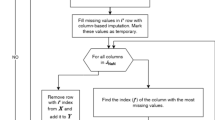Abstract
Tackling missing data is one of the fundamental data pre-processing steps. Data analysis and pattern extraction are affected due to the underlying differences between instances with and without missing data. This is a particular problem with ordinal data, where for example a sample of a population may have all failed to answer a specific question in a questionnaire. The existing methods such as listwise deletion, mean attribute substitution, and regression substitution, naively impute data. They do not impute plausible values as they fail to take into account the relationships between the attributes, but instead consider the distribution of the attribute with missing values only. In this paper we introduce the use of Classification Based Imputation (CNI) to replace missing values with plausible values in ordinal data. The results show that not only does the CNI based technique outperform the existing approaches for imputing missing values in ordinal data but it also helps to improve the classification accuracy of machine learning algorithms.
Access this chapter
Tax calculation will be finalised at checkout
Purchases are for personal use only
Similar content being viewed by others
References
Frank, E., Hall, M.: A simple approach to ordinal classification. In: Raedt, L., Flach, P. (eds.) ECML 2001. LNCS (LNAI), vol. 2167, pp. 145–156. Springer, Heidelberg (2001). doi:10.1007/3-540-44795-4_13
Little, R.J., Rubin, D.B.: Statistical Analysis with Missing Data. Wiley, New York (1987)
Schafer, J.L., Graham, J.W.: Missing data: our view of the state of the art. Psychol. Methods 7(2), 147 (2002)
De Leeuw, E.D., Hox, J., Huisman, M.: Prevention and treatment of item nonresponse. J. Official Stat.-Stockh. 19(2), 153–176 (2003)
Finch, W.H.: Imputation methods for missing categorical questionnaire data: a comparison of approaches. J. Data Sci. 8(3), 361–378 (2010)
Su, X., Greiner, R., Khoshgoftaar, T.M., Napolitano, A.: Using classifier-based nominal imputation to improve machine learning. In: Huang, J.Z., Cao, L., Srivastava, J. (eds.) PAKDD 2011. LNCS (LNAI), vol. 6634, pp. 124–135. Springer, Heidelberg (2011). doi:10.1007/978-3-642-20841-6_11
Huhn, J.C., Hullermeier, E.: Is an ordinal class structure useful in classifier learning? Int. J. Data Min. Modell. Manag. 1(1), 45–67 (2008)
De Leeuw, E.D.: Reducing missing data in surveys: an overview of methods. Qual. Quan. 35(2), 147–160 (2001)
Downey, R.G., King, C.V.: Missing data in likert ratings: a comparison of replacement methods. J. Gen. Psychol. 125(2), 175–191 (1998)
Raaijmakers, Q.A.: Effectiveness of different missing data treatments in surveys with likert-type data: introducing the relative mean substitution approach. Educ. Psychol. Measur. 59(5), 725–748 (1999)
Su, X., Khoshgoftaar, T.M., Greiner, R.: Using imputation techniques to help learn accurate classifiers. In: 20th IEEE International Conference on Tools with Artificial Intelligence, ICTAI 2008, vol. 1, pp. 437–444. IEEE (2008)
Batista, G.E., Monard, M.C.: An analysis of four missing data treatment methods for supervised learning. Appl. Artif. Intell. 17(5–6), 519–533 (2003)
Author information
Authors and Affiliations
Corresponding author
Editor information
Editors and Affiliations
Rights and permissions
Copyright information
© 2017 Springer International Publishing AG
About this paper
Cite this paper
Alam, S., Dobbie, G., Sun, X. (2017). Improving Imputation Accuracy in Ordinal Data Using Classification. In: Madureira, A., Abraham, A., Gamboa, D., Novais, P. (eds) Intelligent Systems Design and Applications. ISDA 2016. Advances in Intelligent Systems and Computing, vol 557. Springer, Cham. https://doi.org/10.1007/978-3-319-53480-0_5
Download citation
DOI: https://doi.org/10.1007/978-3-319-53480-0_5
Published:
Publisher Name: Springer, Cham
Print ISBN: 978-3-319-53479-4
Online ISBN: 978-3-319-53480-0
eBook Packages: EngineeringEngineering (R0)




